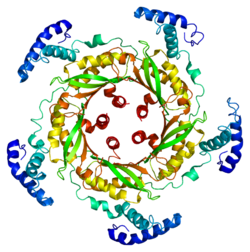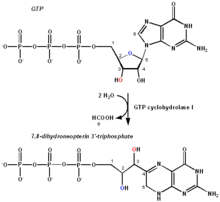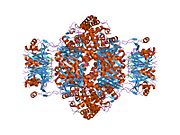| GCH1 |
|---|
 |
| Available structures |
|---|
| PDB | Ortholog search: PDBe RCSB |
|---|
|
|
| Identifiers |
|---|
| Aliases | GCH1, DYT14, DYT5, DYT5a, GCH, GTP-CH-1, GTPCH1, HPABH4B, GTP cyclohydrolase 1 |
|---|
| External IDs | OMIM: 600225; MGI: 95675; HomoloGene: 132; GeneCards: GCH1; OMA:GCH1 - orthologs |
|---|
| Gene location (Human) |
|---|
 | | Chr. | Chromosome 14 (human)[1] |
|---|
| | Band | 14q22.2 | Start | 54,842,008 bp[1] |
|---|
| End | 54,902,826 bp[1] |
|---|
|
| Gene location (Mouse) |
|---|
 | | Chr. | Chromosome 14 (mouse)[2] |
|---|
| | Band | 14 C1|14 24.6 cM | Start | 47,391,352 bp[2] |
|---|
| End | 47,426,870 bp[2] |
|---|
|
| RNA expression pattern |
|---|
| Bgee | | Human | Mouse (ortholog) |
|---|
| Top expressed in | - secondary oocyte
- jejunal mucosa
- kidney tubule
- palpebral conjunctiva
- monocyte
- right lobe of liver
- glomerulus
- metanephric glomerulus
- retinal pigment epithelium
- duodenum
|
| | Top expressed in | - superior cervical ganglion
- pineal gland
- left lobe of liver
- islet of Langerhans
- pyloric antrum
- secondary oocyte
- cumulus cell
- mucous cell of stomach
- adrenal gland
- ileum
|
| | More reference expression data |
|
|---|
| BioGPS |  | | More reference expression data |
|
|---|
|
| Gene ontology |
|---|
| Molecular function | - nucleotide binding
- calcium ion binding
- protein homodimerization activity
- zinc ion binding
- GTP binding
- metal ion binding
- protein binding
- catalytic activity
- hydrolase activity
- GTP cyclohydrolase I activity
- mitogen-activated protein kinase binding
- GTPase activity
- GTP-dependent protein binding
- translation initiation factor binding
| | Cellular component | - cytoplasm
- cytosol
- nuclear membrane
- nucleoplasm
- cytoplasmic vesicle
- nucleus
- neuron projection terminus
- protein-containing complex
| | Biological process | - nitric oxide biosynthetic process
- response to interferon-gamma
- neuromuscular process controlling posture
- protein heterooligomerization
- negative regulation of blood pressure
- dopamine biosynthetic process
- regulation of lung blood pressure
- vasodilation
- pteridine-containing compound biosynthetic process
- 7,8-dihydroneopterin 3'-triphosphate biosynthetic process
- dihydrobiopterin metabolic process
- regulation of blood pressure
- response to tumor necrosis factor
- tetrahydrofolate biosynthetic process
- response to lipopolysaccharide
- positive regulation of nitric-oxide synthase activity
- response to pain
- tetrahydrobiopterin biosynthetic process
- metabolism
- protein homooligomerization
- regulation of removal of superoxide radicals
- positive regulation of heart rate
- protein-containing complex assembly
| | Sources:Amigo / QuickGO |
|
| Orthologs |
|---|
| Species | Human | Mouse |
|---|
| Entrez | | |
|---|
| Ensembl | | |
|---|
| UniProt | | |
|---|
| RefSeq (mRNA) | |
|---|
NM_000161
NM_001024024
NM_001024070
NM_001024071 |
| |
|---|
| RefSeq (protein) | |
|---|
NP_000152
NP_001019195
NP_001019241
NP_001019242 |
| |
|---|
| Location (UCSC) | Chr 14: 54.84 – 54.9 Mb | Chr 14: 47.39 – 47.43 Mb |
|---|
| PubMed search | [3] | [4] |
|---|
|
| Wikidata |
| View/Edit Human | View/Edit Mouse |
|
GTP cyclohydrolase I (GTPCH) (EC 3.5.4.16) is a member of the GTP cyclohydrolase family of enzymes. GTPCH is part of the folate and biopterin biosynthesis pathways. It is responsible for the hydrolysis of guanosine triphosphate (GTP) to form 7,8-dihydroneopterin triphosphate (7,8-DHNP-3'-TP, 7,8-NH2-3'-TP).
Gene
GTPCH is encoded by the gene GCH1. Several alternatively spliced transcript variants encoding different isoforms have been described; however, not all of the variants give rise to a functional enzyme.[5]
Clinical significance
At least 94 disease-causing mutations in this gene have been discovered.[6] Mutations in this gene are associated with two disorders: autosomal recessive GTP cyclohydrolase I deficiency and autosomal dominant GTP cyclohydrolase I deficiency. These may present with malignant phenylketonuria (PKU) and hyperphenylalaninemia (HPA)[5] and lead to a lack of certain neurotransmitters (dopamine, norepinephrine, epinephrine and serotonin). The dominant form, with mutation in only one of the two alleles for GTP cyclohydrolase I, causes dopamine-responsive dystonia, characterized by childhood-onset dystonia. Patients with the recessive form have mutations in both alleles for GTP cyclohydrolase I. Patients present with developmental delays and neurological dysfunction with trunk hypotonia, hypertonia of the extremities, abnormal movements, tremors, convulsions, and sometimes autonomic dysfunction.[7] Response to treatment is variable and the long-term and functional outcome is unknown. To provide a basis for improving the understanding of the epidemiology, genotype/phenotype correlation and outcome of these diseases their impact on the quality of life of patients, and for evaluating diagnostic and therapeutic strategies a patient registry was established by the noncommercial International Working Group on Neurotransmitter Related Disorders (iNTD).[8]
Function
The transcribed protein is the first and rate-limiting enzyme in tetrahydrobiopterin (THB, BH4) biosynthesis, catalyzing the conversion of GTP into 7,8-DHNP-3'-TP. THB is an essential cofactor required by the aromatic amino acid hydroxylase (AAAH) and nitric oxide synthase (NOS) enzymes in the biosynthesis of the monoamine neurotransmitters serotonin (5-hydroxytryptamine (5-HT)), melatonin, dopamine, norepinephrine (noradrenaline), and epinephrine (adrenaline), and nitric oxide (NO), respectively.[citation needed]
GTPCH (GCH1) and tetrahydrobiopterin were found to protect against cell death by ferroptosis. Tetrahydrobiopterin (BH4) acts as a potent, diffusable antioxidant that resists oxidative stress and enables cancer cell survival.[9]
See also
References
- ^ a b c GRCh38: Ensembl release 89: ENSG00000131979 – Ensembl, May 2017
- ^ a b c GRCm38: Ensembl release 89: ENSMUSG00000037580 – Ensembl, May 2017
- ^ "Human PubMed Reference:". National Center for Biotechnology Information, U.S. National Library of Medicine.
- ^ "Mouse PubMed Reference:". National Center for Biotechnology Information, U.S. National Library of Medicine.
- ^ a b "Entrez Gene: GCH1 GTP Cyclohydrolase 1 (DOPA-Responsive Dystonia)".
- ^ Šimčíková D, Heneberg P (December 2019). "Refinement of evolutionary medicine predictions based on clinical evidence for the manifestations of Mendelian diseases". Scientific Reports. 9 (1): 18577. Bibcode:2019NatSR...918577S. doi:10.1038/s41598-019-54976-4. PMC 6901466. PMID 31819097.
- ^ Longo N (June 2009). "Disorders of biopterin metabolism". Journal of Inherited Metabolic Disease. 32 (3): 333–42. doi:10.1007/s10545-009-1067-2. PMID 19234759. S2CID 13117236.
- ^ "Patient registry".
- ^ Kraft VA, Bezjian CT, Pfeiffer S, Ringelstetter L, Müller C, Zandkarimi F, Merl-Pham J, Bao X, Anastasov N, Kössl J, Brandner S, Daniels JD, Schmitt-Kopplin P, Hauck SM, Stockwell BR, Hadian K, Schick JA (January 2020). "GTP Cyclohydrolase 1/Tetrahydrobiopterin Counteract Ferroptosis through Lipid Remodeling". ACS Central Science. 6 (1): 41–53. doi:10.1021/acscentsci.9b01063. PMC 6978838. PMID 31989025.
Further reading
- Voet JG, Voet D (2004). Biochemistry. New York: J. Wiley & Sons. ISBN 0-471-39223-5.
External links
- GTP+Cyclohydrolase+I at the U.S. National Library of Medicine Medical Subject Headings (MeSH)
- GeneReviews/NCBI/NIH/UW entry on GTP Cyclohydrolase 1-Deficient Dopa-Responsive Dystonia
- Overview of all the structural information available in the PDB for UniProt: P30793 (Human GTP cyclohydrolase 1) at the PDBe-KB.
PDB gallery
-
1fb1: CRYSTAL STRUCTURE OF HUMAN GTP CYCLOHYDROLASE I -
1is7: Crystal structure of rat GTPCHI/GFRP stimulatory complex -
1is8: Crystal structure of rat GTPCHI/GFRP stimulatory complex plus Zn -
1wpl: Crystal structure of the inhibitory form of rat GTP cyclohydrolase I/GFRP complex |
|
|---|
| Activity | |
|---|
| Regulation | |
|---|
| Classification | |
|---|
| Kinetics | |
|---|
| Types | |
|---|
|
|---|
| Fat soluble vitamins | |
|---|
| Water soluble vitamins | |
|---|
| Nonvitamin cofactors | |
|---|
|
|---|
| Activity | |
|---|
| Regulation | |
|---|
| Classification | |
|---|
| Kinetics | |
|---|
| Types | |
|---|
Portal: Biology
Biology


 1fb1: CRYSTAL STRUCTURE OF HUMAN GTP CYCLOHYDROLASE I
1fb1: CRYSTAL STRUCTURE OF HUMAN GTP CYCLOHYDROLASE I 1is7: Crystal structure of rat GTPCHI/GFRP stimulatory complex
1is7: Crystal structure of rat GTPCHI/GFRP stimulatory complex 1is8: Crystal structure of rat GTPCHI/GFRP stimulatory complex plus Zn
1is8: Crystal structure of rat GTPCHI/GFRP stimulatory complex plus Zn 1wpl: Crystal structure of the inhibitory form of rat GTP cyclohydrolase I/GFRP complex
1wpl: Crystal structure of the inhibitory form of rat GTP cyclohydrolase I/GFRP complex




















